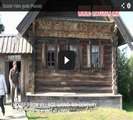Dominating the town's southern view, the shining
golden dome could be seen about twelve kilometres away on the high ground where
the road to Murom and Ryazan ran through dense Sorest. The cathedral was
clearly visible from the west, the town side, and also, from the north and
east, i. e., the roads to Yurlev-Polekoy, Suzdal and Bogoliubovo. A few decades
later the cathedral lost its original appearance due to Ure and subsequent
rebuilding. We shall examine It further below.
Andrey also took steps to fortify the capital. It’s
ring of defences was extended. The circumference of the earth ramparts was increased
to seven kilometers and they were topped by wooden walls containing a system of
gateways, which were called the Golden, Silver, Bronze and Irina gates. The
Golden Gate (1158 - 1164) is still standing. Being a fortified structure, It was
designed without any provision for sculptural ornament. The material used was
local well-dressed stone. Its original elongated proportions were distorted buy
the addition of circular towers in the eighteenth century.
The actual arched gateway, fourteen meters high, has
not been altered and helps one to reconstruct the original proportions of the
building as a whole. H was a huge triumphal arch for ceremonial entrances Into
the town. The vaults of the arcfe rest on simple imposts and plain pilaster
strips. An arched cross-piece was added halfway up the gateway for defensive
purposes. The carved oak gates, covered with sheets of gilded copper, reached
up to the cross-piece. At the same level as the cross-piece was a wooden
platform from which the town's defenders could shoot arrows at the enemy. The
staircase in the wall to the look-out platform is a common feature of this
type of fortified structure.
Bogoliubovo with Prince Andreyls palace contpiex is on
the outskirts of Vladimir. Us centre was the cathedral which was begun about
the same time as the Cathedral of the Dormition and was built in accordance
with the traditions of its time. This cathedral survived until the end of the
seventeenth century. A new one was erected on the same spot in the eighteenth
century, incorporating details of the old one. It too was dedicated to the
cult of the Virgin Mary - the Nativity of the Virgin. The priest Mikula, who
was a close friend of the prince, left a description of the beauty and lavish
decoration of the original cathedral, Its ''gold" floors, the portals and
doors decorated with bands of "gold", and the sumptuous church-plate,
and also of how the prince ordered envoys from Kiev and other lands to be taken
up to the choir gallery so that they might see the cathedral in all its splendor
witnessing to the glory of the Vladimir prince. The cathedral impressed
everyone by the abundance of light In Its soaring interior. Its bronze floor
and also the mirror-like surface of the majolica floor in the choir gallery
reflected the light streaming in throught the windows and coming from the
burning candles.
Next to the cathedral stood the Prince's palace,
linked to it by an arched passageway and a tower. There was another passageway
which led to the fortress walls in case of sudden attack. A slender,
eight-columned cinorlum with a chalice (replaced by the existing one in the
seventeenth century) for holy water stood by the west front. All the buildings
in the ensemble, which was completed by 1165, were stylistically united by traditional
decorative elements. They were surrounded by white-stone paving with guttering
to drain water from the palace square. All that has survived of this splendid
palace, however, is a fragment of the Prince's cathedral with the adjoining
passageway on semicircular arches and the lower section of a square tower with
a stone spiral staircase.
The Church of the Intercession on the Nerl (1165) is
an exquisite specimen not only of the Vladimir-Suzdalian school but of world
architecture m general. Ereсted
to commemorate a victory over the Volga Bulgars, it also served as a memorial
to Andrey's son Iziaslav who paid for this victory with his life. It was built on an artificial mound,
originally paved with white stone, to keep it above the spring flood waters.
This was the first miracle In stone seen by visitors arriving by boat. It comes
into view as soon as you leave Bogoliubovo and cross the water-meadows carpeted
with flowers and grasses to the Old Kliazma Pond gleaming in the sun.
The structure of its architectural divisions is such
that it seems to be soaring into the sky. This impression is enhanced by the
barely protruding apses, partially covered with powerful corner pilasters. The
central apse is somewhat higher, thereby breaking the horizontal line of the
band of arcading and the sanctuary window. More vertical emphasis is supplied
by the multiple pilasters and, in the upper tier, by the shaping of the arched
wall terminations and the tall, narrow windows, as well as the slender, closely
spaced columns of the band arcading on brackets. The exquisite sculptural
ornament is arranged in such a way that it covers the horizontal lines between
the rows of white-stone masonry, again stressing the general vertical
movement. Each of the three fronts has the same compositions - King David in
the centre with a lion and a bird of prey on either side. Beneath it are
female masks with braided hair.
After the murder of Andrey Bogoliubsky In 1174
a struggle ensued which resulted in Vsevolod III coming to the throne. For
almost ten years he sought to subject enemies "to his will". There
was hardly any building during this period. Not until 1185 after a great fire
in Vladimir did Vsevolod begin to
build new galleries round
the Dormition Cathedral.





No comments:
Post a Comment